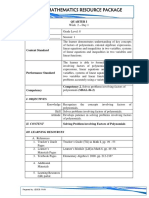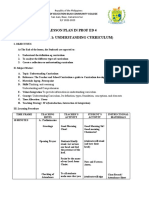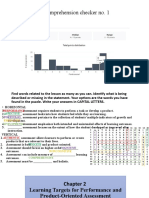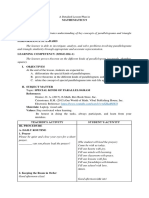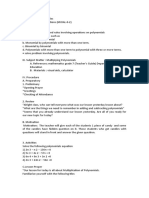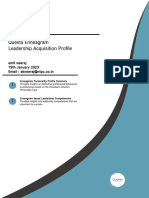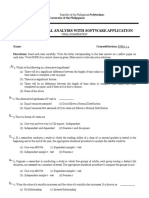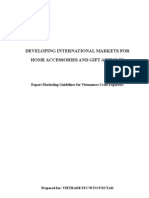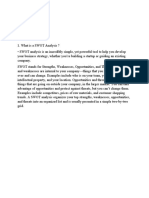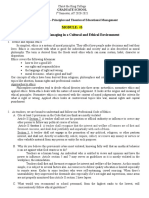EDUC 155 Module 04 Lesson 01
EDUC 155 Module 04 Lesson 01
Uploaded by
jay-ar saludaresCopyright:
Available Formats
EDUC 155 Module 04 Lesson 01
EDUC 155 Module 04 Lesson 01
Uploaded by
jay-ar saludaresOriginal Title
Copyright
Available Formats
Share this document
Did you find this document useful?
Is this content inappropriate?
Copyright:
Available Formats
EDUC 155 Module 04 Lesson 01
EDUC 155 Module 04 Lesson 01
Uploaded by
jay-ar saludaresCopyright:
Available Formats
MARIANO MARCOS STATE UNIVERSITY
College of Teacher Education
About the Course Guide
This course EDUC 155 – Assessment in Learning 2 consist of 4 units. It focuses on the
principles, development and utilization of alternative forms of assessment in measuring
authentic learning. It emphasizes on how to assess process- and product-oriented learning
outcomes as well as affective learning. Students will experience how to develop rubrics and
other assessment tools for performance-based and product-based assessment.
Course Objectives
At the end of the course, the students should have:
1. distinguished between traditional and authentic assessment
processes and tools,
2. planned and developed alternative/authentic forms of
assessment and scoring tools; and
3. utilized different assessment and scoring tools in different
performance-based learning.
Course Content
This consists of four (4) unit and assignments at the end of each unit. Each lesson
was developed to cover one major topic which aims to provide the learner and in-depth
understanding of the measurement and evaluation procedures that underpin testing in the
three domains. The course covers the following topics:
1. Authentic Assessment in the Classroom (Unit 1);
2. Performance Assessments (Unit 2);
3. Authentic Assessment of the Affective Domain (Unit 3); and
4. Communicating Authentic Assessment Results (Unit 4)
Numerous required and suggested readings will be given for a better
understanding of the content. Learning activities and/or Self-Assessment
Exercises (SAEs) are also included in each unit to broaden your knowledge of the
topics discussed in the unit.
Castro Ave., Laoag City, 2900 Ilocos Norte, Philippines
cte@mmsu.edu.ph (077) 600-2014 www.mmsu.edu.ph
MARIANO MARCOS STATE UNIVERSITY
College of Teacher Education
Module COMMUNICATING AUTHENTIC
4 ASSESSMENT RESULTS
Introduction
With information from assessment and evaluation, teachers can make decisions about
what to focus on in the curriculum and when to focus on it. Assessment identifies who
needs extra support, who needs greater challenge, who needs extra practice and who is
ready to move on. The primary goal of assessment is to provide ongoing feedback to
teachers, students and parents, in order to enhance teaching and learning. Assessing,
evaluating and communicating student achievement and growth are integral parts of
schooling. They should be positive experiences for students, should promote growth, and be
carried out in such a way that they support continuous learning and development.
The final steps of the Assessment Cycle involve reporting assessment results and,
most importantly, using those results to make programmatic changes to improve student
learning. Communicating information about assessment and evaluation is a necessary step
in the instructional process. The purpose of assessment— gathering information so that wise
decisions about further teaching and learning can be made—requires that information be
communicated to others.
This unit covers the following topics that allow you to efficiently and effectively
communicate authentic assessment results:
A. Effective Communication
1. What to communicate?
2. Why communicate?
3. How to communicate?
4. Managing Message Quality
5. Managing Interpersonal Dynamics
B. Portfolio as a Communication Medium
1. Portfolios and Authentic Assessment
a. Nature and Characteristics
b. Analyzing the Key Components of Portfolios
2. Types and Uses
3. e-Portfolios
Castro Ave., Laoag City, 2900 Ilocos Norte, Philippines
cte@mmsu.edu.ph (077) 600-2014 www.mmsu.edu.ph
MARIANO MARCOS STATE UNIVERSITY
College of Teacher Education
C. Grading and Reporting
1. Reporting to Parents
a. Report Cards
b. Parent-Teacher Conference
c. Other Communications
Expected Learning
Outcomes
In this unit, you are expected to have:
1. demonstrated knowledge on how to design and develop portfolios for
authentic assessment of learning outcomes;
2. explained how to report, punctually and accurately, results of
assessment of learner academic performance and achievement in the
form of grades, marks, descriptors or narratives; and
3. discussed how to articulate to parents the learning needs, progress, and
behavior of the learners during a parent-teacher conference or other
appropriate situation.
LESSON HIGHLIGHTS
Lesson 1 – Effective
Communication
What to Communicate?
After an assessment plan has been designed for each domain (psychomotor,
cognitive, and affective), the issue of what to do with the assessment remains. While
assessment can certainly be useful to students, teachers, and administrators internally,
specifically for improving the teaching and learning process and for evaluating program
effectiveness, assessment also needs to be used externally—it must be aggregated
somehow and meaningfully presented to parents as an indication of what their children have
achieved over the short term and over the long term. However, the critical question in the
communication of results is, “ What information or details about the students’ performances
should be reported?”
Castro Ave., Laoag City, 2900 Ilocos Norte, Philippines
cte@mmsu.edu.ph (077) 600-2014 www.mmsu.edu.ph
MARIANO MARCOS STATE UNIVERSITY
College of Teacher Education
It is important that assessment, evaluation and communication should be congruent
with the following principles, in order to ensure that what is being externally reported (to
parents, for instance) are grounded on existing educational foundations:
1. Assessment, evaluation and communication of student growth are based on the
curriculum and are in line with the school’s philosophy and programming
principles.
2. Information about methods of assessment and results of evaluation are available
to students, parents and the community.
3. Student growth is assessed, evaluated and communicated for all outcomes.
4. Evaluation and communication of student growth are ongoing and are used to
plan effective programming.
5. Student growth is enhanced when students participate in the assessment,
evaluation and communication processes.
6. Student growth is enhanced when assessment, evaluation and communication are
viewed positively by students.
7. Methods of communicating student growth vary depending on audience and
purpose.
Why Communicate?
Effective communication informs students, parents and others about what
has been accomplished and what the next steps are in the learning process. The
communication process is a team effort. However, the greater the role students are
given in this process, the richer the information that is shared and the greater the impact on
future student learning. Students need feedback on how they are learning and performing.
If it is to be beneficial, feedback must extend beyond scores or marks, providing
useful information about the meaning of these results and suggestions for ways
to improve, grow or extend learning. Communication needs to be continuous.
Comments and observations shared with students in class are effective ways for teachers to
communicate information about student learning.
Parents also need ongoing communication. Communicating results of authentic
assessment explores many important life choices and decisions, and parental
awareness and input can be valuable for both students and schools. Students can
also benefit from formalized opportunities to communicate with parents in a school setting.
Informing parents of results is an important aspect of assessment for two reasons. First,
parents need solid information about their child’s learning progress in order to
determine whether or not their child’s needs are being met. Second,
communicating assessment information to parents also provides a good public-
relations opportunity and helps build support for educational programs.
Another importance of communicating authentic assessment results is to make
changes in educational programs that improve student learning or development. This
learning improvement process requires practitioners to:
Castro Ave., Laoag City, 2900 Ilocos Norte, Philippines
cte@mmsu.edu.ph (077) 600-2014 www.mmsu.edu.ph
MARIANO MARCOS STATE UNIVERSITY
College of Teacher Education
1. meaningfully assess student learning or development;
2. effectively intervene via theory-based programming; and
3. re-assess to verify better learning or development.
The Simple Model for Learning Improvement
ASSESS INTERVENE RE-ASSESS
Collect baseline data Administer a theory- Gather evidences that
from students’ based intervention verify the occurrence
performance, to which that address of a change in the
future student weaknesses educational program
achievement can be identified, and then which “improved”
compared evaluate its impact student learning
How to Communicate?
Reporting systems most highly regarded by parents typically include a mix of
traditional and more modern reporting tools. Tools that might be included in the
comprehensive reporting system include:
Report Cards
Notes from Teachers—this way of communicating can
invite parental response and involvement
Videos of Student and/or Group Activities—presentations
can be documented for parent viewing and recorded media
could be circulated from one home to another
Phone Calls or Email Messages
Weekly/Monthly Progress Reports
School Open-Houses or Special Events, such as
presentations, displays, classroom visits
Class and School Newsletters
Personal Letter to Parents
Evaluated Projects or Assignments
Portfolio’s or Exhibits of Students’ Work
Homework Assignments or Homework Hotlines
School Web Pages
Learning Conferences—these can involve parents or can be
student-led with parents and teachers participating
Castro Ave., Laoag City, 2900 Ilocos Norte, Philippines
cte@mmsu.edu.ph (077) 600-2014 www.mmsu.edu.ph
MARIANO MARCOS STATE UNIVERSITY
College of Teacher Education
The succeeding table shows an example of a brief narrative report on student’s
performance in a single content area. It is important for you to know, however, that there
are several structures or formats that can be used in creating reports for authentic
assessment results. The Department of Education (DepEd) in the Philippines has its own set
of templates for such purpose. You may also construct your own, contextualized template
for communicating assessment results to your students or to their parents.
Student Name: Jane Domingo Subject Area: Reading
Castro Ave., Laoag City, 2900 Ilocos Norte, Philippines
cte@mmsu.edu.ph (077) 600-2014 www.mmsu.edu.ph
MARIANO MARCOS STATE UNIVERSITY
College of Teacher Education
You may watch the YouTube videos below in order for you to have an idea on how
learning conferences work in the communication or reporting of authentic assessment
results. The first video presents a parent-teacher conference, whereas the second shows
how student-led conference is implemented. Take note of the turn-taking strategies and the
roles that are being employed and taken by the participants in the said conferences.
First Video: Parent-Teacher Conference
YouTube Link: https://www.youtube.com/watch?v=opJiN2r7-Gc
Video Length: 2 Minutes and 52 Seconds
Second Video: Student-Led Conference
YouTube Link: https://www.youtube.com/watch?v=L_WBSInDc2E
Video Length: 5 Minutes and 5 Seconds
Castro Ave., Laoag City, 2900 Ilocos Norte, Philippines
cte@mmsu.edu.ph (077) 600-2014 www.mmsu.edu.ph
MARIANO MARCOS STATE UNIVERSITY
College of Teacher Education
Managing Message Quality
When communicating assessment results, the primary goal should always be to
encourage action. Along these lines, results have the best chance of being used when
they: 1) tell a meaningful story, 2) are clear, concise, and compelling, and 3)
adequately address reasonable critiques. The general guidelines below were adapted
from Linda Suskie's book, “Assessing Student Learning” (2010).
3Cs (Clear, Concise, Address Reasonable
Tell a Meaningful Story
and Compelling) Critiques
Tailor assessment results to your Avoid jargon Provide
audience (understand their Use numbers corroborating
needs, perspectives, and sparingly information
priorities) Use data visualization (triangulation)
Highlight interesting and techniques when Document the
unanticipated findings appropriate to clearly quality of your
Emphasize meaningful differences communicate clearly assessment strategy
Focus on matters your audience and compellingly Acknowledge
can do something about possible flaws in
Provide context for your results your assessment
Offer informed commentary strategy
Giving students feedback on their learning, often described as formative
assessment, has been shown to have powerful positive benefits for student
learning and achievement (Juwah et al, 2009; Black & William, 1998). The importance of
feedback mechanisms in assessment has been well established in research (Fisher & Miller,
2008). However, this can often be a time-consuming task in an environment with stretched
resources. In addition, many teachers report lack of student engagement with this feedback;
for example, students may not read it, while also reporting a lack of helpful feedback. This
can result in wasted teachers’ efforts and ineffective feedback for students.
One of the key themes emerging to address this dilemma is to develop
students own self-monitoring skills in order to help them narrow the gap between their
performance and the standards expected of them (Clarke et al, 2001). The timing, type
and specification of feedback can improve student ability to self-monitor. In addition,
good feedback should feed into some specific actions that can be used in the next
assessment. Feedback need not always be from the teacher, as students themselves are a
good resource to each other when given guidance on how to provide feedback. New
technologies also open up some efficient feedback opportunities.
This module highlights six feedback strategies on students’ assessment. It
encompasses feedback given from teachers to students and where students self-monitor,
Castro Ave., Laoag City, 2900 Ilocos Norte, Philippines
cte@mmsu.edu.ph (077) 600-2014 www.mmsu.edu.ph
MARIANO MARCOS STATE UNIVERSITY
College of Teacher Education
review and critically evaluate their own and/or their peers’ work. It sets outs different
technologies to support these strategies.
Strategy Examples Technology Type
1. Feedback individually Oral feedback to the student Online meeting or virtual
to students, post- (synchronous) classroom tools, which can
assessment facilitate individual feedback
This can be through sessions where feedback could
different approaches, be discussed, documents
such as oral, audio, video shared or edited on screen
and/or written/annotated
feedback, either in-class, Written feedback on Feedback files and markup
out of class, in meetings, assignments/ homework documents (via VLE/email),
through a virtual learning rubrics or marking grids and
environment (VLE), by other markup document tools
email, using rubrics, etc.
Audio and video feedback to Inbuilt VLE tools to record
student (asynchronous) audio or video feedback in VLE
2. Group/ class feedback, Oral feedback to the class Online meeting or virtual
post-assessment (synchronous) classroom tools which can
This can be through facilitate group feedback
different approaches, sessions where feedback could
such as oral, audio, video be discussed, documents
and/or written feedback, shared/edited on screen
either in-class, out of
class, in meetings, Written feedback to whole VLE functionalities (Class/group
through the VLE, by class, or groups of students announcements, feedback text
email, etc. within the class files, rubrics/marking grids)
and markup document tools
Generic feedback to class via VLE tools to record audio or
video or audio (asynchronous) video feedback in VLE, other
tools that allow creation of
audio and video (screencast)
feedback files
3. Feedback individually Oral feedback to the student Online meeting or virtual
to students, on an (synchronous) classroom tools which can
activity or draft prior facilitate individual feedback
to summative sessions where drafts could be
assessment discussed, documents
This can be through shared/edited on screen
different approaches,
such as oral, audio, video Written feedback on draft Feedback files and markup
and/or written feedback, assignment documents (via VLE/email),
either in-class, out of rubrics/marking grids and other
class, in meetings, markup document tools
through the VLE, by
email, using rubrics, etc. Audio and video feedback to Inbuilt VLE tools to record
student (asynchronous) audio or video feedback in VLE
Castro Ave., Laoag City, 2900 Ilocos Norte, Philippines
cte@mmsu.edu.ph (077) 600-2014 www.mmsu.edu.ph
MARIANO MARCOS STATE UNIVERSITY
College of Teacher Education
and other audio and video
creation tools
4. Online automated Online graded/ungraded VLE quiz and survey tools
feedback quizzes and self assessments providing standardized
This can be facilitated feedback for particular
through, for example, responses
online multiple-choice
quizzes with feedback, Automated feedback based on Intelligent tutoring automates
essay correcting software, student performance of a task feedback on tasks, triggered by
online polling activities, a specific score on a quiz or
other automated feedback associated rubric
approaches, etc.
Feedback on writing Plagiarism software
development, grammar and
spell checker
5. Self-Assessment Activities to facilitate students ePortfolio and personal
Activities to self-monitor and talk about development planning tools for
Activities to facilitate their work reflection and discussion
students to self-monitor
and critically evaluate Concept/mind mapping online
their own work, such as tools either in class/online/out-
discussion following in of-class (prior to assessment)
class student response
systems/quizzes; Use of a self-assessment form
discussion forums around when submitting work in
assignments in either in Assignment Folder in VLE
class/ online/ out of class;
use of self-assessment Blogs/social networking
form (or rubric) when sites/online communities etc
submitting their work; self
assessing their work Self-evaluation against
against descriptive criteria competencies
on a rubric, etc.
6. Peer Review Activities Students actively working on Peer assessment tool
Opportunities for students criteria in-class/online integrated in VLE
to peer review, for assessment; peer reviewing
example: using a range of against criteria
different exemplars of
other students’ work, Opportunities to peer and/or Online Exemplars shared and
either in class/ online; self-review using exemplars of judged by the students
opportunities to discuss other students’ work, either in
standards required based class/online (prior to
on peer exemplars or assessment) Peer/ team
descriptive criteria on a reviewing against criteria;
rubric; peer reviewing
other students’ work
against descriptive criteria
on a rubric, etc.
Castro Ave., Laoag City, 2900 Ilocos Norte, Philippines
cte@mmsu.edu.ph (077) 600-2014 www.mmsu.edu.ph
MARIANO MARCOS STATE UNIVERSITY
College of Teacher Education
Managing Interpersonal Dynamics
A. How do teachers develop relationships with students that promote student
involved assessment?
It is essential that teachers first establish a close, trusting
relationship with students. Being present, and open, listening without judging,
seeking common understandings, and viewing learning as mutual all lead to the
development of a positive collaborative atmosphere. A teacher should seek to
inspire students through their own passion for ongoing growth and show
young people why they should be committed to their own development.
Teachers should ask themselves, "How can I communicate assessment results that
would enable and encourage students to take risks and reattempt tasks at which
they have failed or been incapable of completing in the past?" and "What grading
practices motivate students to continually strive for mastery and excellence?"
B. How do teachers set up situations so that students are more involved in
determining the course of their learning?
A powerful way to involve students in their learning is to systematically
engage them in shared goal setting. In order for students to set goals and monitor
their progress, they must clearly understand that learning is essential. When
students are involved in setting goals and have a clear understanding of
their mission, they have a sense of ownership, self-awareness, and
control of their own development over time. Some questions for students
might be: "What are your strengths and weakness in the discipline at hand?" and
"What do you see as the greatest challenge for you as you move towards mastery
in this area?" and "How will this goal inform your next steps as a learner?" As a
result of this inclusive process, students are intrinsically motivated to take the
necessary steps to achieve those goals.
C. What are some ways that students can use communication skills to
empower themselves in their learning?
Portfolios "provide an ideal venue for getting [students] to take notice of,
keep track of, and celebrate their learning. Collecting, organizing, and
reflecting on their own work builds an understanding of themselves as
learners and nurtures a sense of accomplishment. Becoming reflective
learners, developing an internal feedback loop, learning to set goals, and noticing
new competencies and new challenges are all habits of thought we can cultivate in
students through the use of portfolios." (Stiggins, 2004)
Castro Ave., Laoag City, 2900 Ilocos Norte, Philippines
cte@mmsu.edu.ph (077) 600-2014 www.mmsu.edu.ph
MARIANO MARCOS STATE UNIVERSITY
College of Teacher Education
Students also benefit when they communicate their parents about their
progress. Student-planned and lead conferences with teachers and
parents creates a shared, interdependent audience for student self-
assessment. Selecting work to discuss, talking about their strengths and
weaknesses, and sharing goals helps students to process learning. Teachers might
guide students in preparing for the conference by supplying a framework like the
one below.
D. How do teachers help parents understand the results of authentic
assessment?
While teachers are certainly on the front lines when it comes
to communicating with students about testing, we cannot forget the important role
that parents play in assessments. Talking to parents about assessment
results is an important step in helping parents understand their child’s
growth, be a partner in goal setting, and generally give them a role in
improving their child’s learning.
Teachers could guide parents in helping them not only understand
assessment and assessment results, but also in preparing their children for
assessment.
Have them meet with you as often as needed to discuss their child’s
progress.
Suggest activities to do at home to help improve their child’s
understanding of schoolwork.
Encourage them to have a quiet, comfortable place for their child to
study at home, if possible – and free of digital distractions.
Remind them that it’s important for their child to be well rested on
school days and especially on the day of a test. Children who are tired
are less able to pay attention in class or to handle the demands of a
test.
Help them understand the importance of providing books and
magazines for their child to read at home. Suggest outside reading
lists or provide suggestions from the public library.
When it comes to the assessment itself, teachers can start with the basics to
help parents better understand the process and improve communications with
them.
Explain the purpose of the assessment – such as the difference
between those used to inform classroom instruction and those needed
to meet state requirements.
Share with them which tests are being used in their child’s classroom
and how the results of each are used.
Castro Ave., Laoag City, 2900 Ilocos Norte, Philippines
cte@mmsu.edu.ph (077) 600-2014 www.mmsu.edu.ph
MARIANO MARCOS STATE UNIVERSITY
College of Teacher Education
Send a communication about when the tests are being given, when
the results will be available, and how the parents will receive the
results.
Share their child’s learning progress using assessment results as well
as your classroom observations.
Point out academic strengths and weaknesses and how they can help
address areas of concern outside of the classroom – particularly if
assessment results point to specific things they can do.
LEARNING ACTIVITY
-A
Activity A
Education has recently shifted from brick-and-mortar approach toward online learning
approach, where teachers and students now conduct their pedagogical engagements in
various virtual learning environments or digital platforms. Such an arrangement has been
resulting in educational issues. One of which is communicating results of authentic
assessments, where teachers find it challenging to provide qualitative feedbacks to their
students’ products and performances, and where students more often than not completes
tasks without meaningful feedback on assessment results.
Using all the concepts that you have learned in this module, answer the following
questions by explanation and exemplification.
Self-Survey on Communicating Authentic Assessment Results
in Online Teaching and Learning
Questions Your Answers
1. What are the common strategies use by
your teachers to communicate results of
your product-based or performance-
based assessments?
2. In what way/s would you like your
teachers communicate the results of
your authentic assessments?
Castro Ave., Laoag City, 2900 Ilocos Norte, Philippines
cte@mmsu.edu.ph (077) 600-2014 www.mmsu.edu.ph
MARIANO MARCOS STATE UNIVERSITY
College of Teacher Education
3. What difficulties or challenges have you
been encountering when it comes to
communicating authentic assessment
results, taking the present educational
conditions into account?
4. How have you been dealing with these
difficulties and challenges?
5. If you were to initiate a student-led
conference, together with your teachers
and/or parents, how would you evaluate
yourself in terms of your overall
performance this course or in your other
courses? Select and course, and then
specify your strengths and weaknesses.
References/Further
Readings
References
Albermale County Public Schools (.n.d.). Framework for quality learning: Assessment
analysis, communication, and feedback. Retrieved from
https://inside.k12albemarle.org/acps/division/fql/Pages/Assessment-Analysis-
Communication-and-Feedback.aspx
Alberta Learning (2002). CALM guide to implementation: Assess, evaluate and communicate
student learning. Retrieved from:
https://education.alberta.ca/media/482270/calm_ch8.pdf
Bobowski, K. (2018). 10 ways for teachers and parents to communicate better about
assessments. Retrieved from https://www.nwea.org/blog/2018/10-ways-for-teachers-
Castro Ave., Laoag City, 2900 Ilocos Norte, Philippines
cte@mmsu.edu.ph (077) 600-2014 www.mmsu.edu.ph
MARIANO MARCOS STATE UNIVERSITY
College of Teacher Education
parents-to-communicate-better-about-assessments/
James Madison University (2021). Reporting and use of assessment results . Retrieved from
https://www.jmu.edu/assessment/sass/AC-step-seven.shtml#:~:text=When
%20communicating%20assessment%20results%2C%20the,3)%20adequately
%20address%20reasonable%20critiques
UCD Teaching & Learning (2021). Teaching toolkit: Giving effective feedback. Retrieved
from https://www.ucd.ie/teaching/resources/teachingtoolkit/givingeffectivefeedback/
Castro Ave., Laoag City, 2900 Ilocos Norte, Philippines
cte@mmsu.edu.ph (077) 600-2014 www.mmsu.edu.ph
You might also like
- MHR405 Chapter 5 NotesDocument8 pagesMHR405 Chapter 5 NotesAhad RizviNo ratings yet
- Sample Implementation PlanDocument4 pagesSample Implementation Plandinky deanNo ratings yet
- Criteria Points/Scores 5 4 3 2 1 Knowledge On The Subject MatterDocument2 pagesCriteria Points/Scores 5 4 3 2 1 Knowledge On The Subject MatterMichelle M. BagoNo ratings yet
- Elementary Algebra I. 2000. Pp. 200-211Document2 pagesElementary Algebra I. 2000. Pp. 200-211マリエ マリエ100% (1)
- Gathering Statistical DataDocument8 pagesGathering Statistical DataianNo ratings yet
- Week 4 Day 2Document2 pagesWeek 4 Day 2Pablo JimeneaNo ratings yet
- Linear Inequalities in Two VariablesDocument7 pagesLinear Inequalities in Two VariablesCleofe Tomas-UndoNo ratings yet
- G7 - Linear Equation FinalDocument7 pagesG7 - Linear Equation FinalAcero, Jessica B.No ratings yet
- Math 7 Learning CompetenciesDocument2 pagesMath 7 Learning CompetenciesZheingay Bohol RivasNo ratings yet
- Lesson 1 Activity 1. Varied Answers Activity 2. 1. F 2. F 3. T 4. F 5. TDocument4 pagesLesson 1 Activity 1. Varied Answers Activity 2. 1. F 2. F 3. T 4. F 5. Tjoy pamorNo ratings yet
- Semi Detailed Lesson Plan FINALDocument5 pagesSemi Detailed Lesson Plan FINALNathalie Cordial100% (1)
- Graphic OrganizerDocument3 pagesGraphic OrganizerAzlina MohamedNo ratings yet
- WEEK 3 Understanding CLSDocument41 pagesWEEK 3 Understanding CLSPrimaNo ratings yet
- Decile For Ungrouped DataDocument3 pagesDecile For Ungrouped DataJoseph OprolodNo ratings yet
- TOS 1st Periodical Exam 2016Document2 pagesTOS 1st Periodical Exam 2016Danilo de MesaNo ratings yet
- Production of Classroom Management Routine and Materials To Be Used During Cooperative Learning StructureDocument3 pagesProduction of Classroom Management Routine and Materials To Be Used During Cooperative Learning StructureMary Ann M. MingoNo ratings yet
- EDUR 8331 14a Item AnalysisDocument6 pagesEDUR 8331 14a Item AnalysisLoey100% (1)
- Problem 7Document1 pageProblem 7Mark Ruby OpawonNo ratings yet
- A Semi-Detailed Lesson Plan in G11-General Mathematics Quarter 1, Week 1Document6 pagesA Semi-Detailed Lesson Plan in G11-General Mathematics Quarter 1, Week 1Erika LisbeNo ratings yet
- Daily Lesson Log of M8Al-Ib-2 (Week 2 Day 3) : Can The Difference of Two Squares Be Applicable To 3 - 12 If No, Why?Document4 pagesDaily Lesson Log of M8Al-Ib-2 (Week 2 Day 3) : Can The Difference of Two Squares Be Applicable To 3 - 12 If No, Why?zirconis10No ratings yet
- Effectiveness of Jigsaw Cooperative Learning Strategy in Solving Quadratic EquationDocument14 pagesEffectiveness of Jigsaw Cooperative Learning Strategy in Solving Quadratic EquationCedie YganoNo ratings yet
- Math 9-Q4-Module-4Document14 pagesMath 9-Q4-Module-4Mark Johnson VillaronNo ratings yet
- Assessment and Evaluation in Teahcing Math Midterm ExamDocument10 pagesAssessment and Evaluation in Teahcing Math Midterm Examhufana.dishelleanneNo ratings yet
- DLP Math 8.1Document6 pagesDLP Math 8.1Val Daryl AnhaoNo ratings yet
- Prof Ed 7 Lesson 2Document7 pagesProf Ed 7 Lesson 2Jonathia Willian AngcaoNo ratings yet
- DLP-8 (Week 2, Day 2)Document6 pagesDLP-8 (Week 2, Day 2)Eleazar Manigo AbesNo ratings yet
- DLP-8 (Week 2 DAY 1)Document9 pagesDLP-8 (Week 2 DAY 1)Magilyn DonatoNo ratings yet
- DLL - Quarter 1 (Patterns and Algebra)Document2 pagesDLL - Quarter 1 (Patterns and Algebra)tee jay ramosNo ratings yet
- Lesson Plan Matatag Final 1Document8 pagesLesson Plan Matatag Final 1romilyn frueldaNo ratings yet
- IV-Day 39Document4 pagesIV-Day 39Florita LagramaNo ratings yet
- Daily Lesson Log: Teaching Dates and TimeDocument12 pagesDaily Lesson Log: Teaching Dates and Timemarvin siegaNo ratings yet
- M7Ge-Iiic-1: Renante Tillo JosolDocument4 pagesM7Ge-Iiic-1: Renante Tillo JosolRenante T. Josol100% (1)
- Bless Me UltimaDocument2 pagesBless Me UltimaMoonton MLNo ratings yet
- 21st Century Assessments & CharacteristicsDocument2 pages21st Century Assessments & CharacteristicsJhay-Ar Espeleta PalarisNo ratings yet
- Principles and Strategies in Teaching Math For StudentsDocument78 pagesPrinciples and Strategies in Teaching Math For StudentsRoy Ivan ReyesNo ratings yet
- Lesson Plan With Assure ModelDocument4 pagesLesson Plan With Assure Modelapi-511774279No ratings yet
- A Detailed Lesson Plan For Mathematics Grade 10Document6 pagesA Detailed Lesson Plan For Mathematics Grade 10Jovie Mae Saban100% (1)
- M-5. Quadrilaterals Jan. 21-25properties of ParallelogramsDocument6 pagesM-5. Quadrilaterals Jan. 21-25properties of ParallelogramsKheza Bohol Deliman DañasNo ratings yet
- Table of Specification - First GradingDocument1 pageTable of Specification - First GradingWellaCelestinoNo ratings yet
- DLP 10Document4 pagesDLP 10Pablo JimeneaNo ratings yet
- A Correlational Analysis On Math Anxiety and Mathematical Performance of Grade 10 Students in Morong National High SchoolDocument10 pagesA Correlational Analysis On Math Anxiety and Mathematical Performance of Grade 10 Students in Morong National High SchoolPsychology and Education: A Multidisciplinary JournalNo ratings yet
- Detailed Lesson PlanDocument15 pagesDetailed Lesson PlanStephanie BondocNo ratings yet
- 7es Lesson Plan Angle PairsDocument7 pages7es Lesson Plan Angle PairsgarcianocrispaulNo ratings yet
- 7e Lesson Plan For DepedDocument17 pages7e Lesson Plan For DepedRozelyn Rodil Leal-LayanteNo ratings yet
- Lesson Plan in Prof Ed 4Document7 pagesLesson Plan in Prof Ed 4Bantayan Melody Gwyneth B.No ratings yet
- Counting The Number of Occurences of An Outcome in An ExperimentDocument5 pagesCounting The Number of Occurences of An Outcome in An ExperimentNiña Romina G. Navalta50% (2)
- Complementary, Supplementary LP - AmiraDocument4 pagesComplementary, Supplementary LP - AmiraKristel Ann VictorianoNo ratings yet
- Name: Date: Year & Section Subject:: ST NDDocument2 pagesName: Date: Year & Section Subject:: ST NDFaizal MaligaNo ratings yet
- Difficulties and Coping Strategies of BSED Mathematics College Students in Dealing With Worded ProblemsDocument9 pagesDifficulties and Coping Strategies of BSED Mathematics College Students in Dealing With Worded ProblemsPsychology and Education: A Multidisciplinary JournalNo ratings yet
- Module 1 - Lesson 1Document6 pagesModule 1 - Lesson 1Chabelita Languban CabriaNo ratings yet
- Semi-Detailed Lesson Plan in Mathematics 10: Space Sample of Number Event of Number E PDocument2 pagesSemi-Detailed Lesson Plan in Mathematics 10: Space Sample of Number Event of Number E PJJ Delegero BergadoNo ratings yet
- M7NS Ia 1Document6 pagesM7NS Ia 1jennelyn malayno0% (1)
- Chapter 2 Learning Targets For Performance and Product-Oriented AssessmentDocument29 pagesChapter 2 Learning Targets For Performance and Product-Oriented AssessmentLyle Lovett Afable100% (1)
- Learning Competencies: TotalDocument4 pagesLearning Competencies: TotalLaira Joy Salvador - ViernesNo ratings yet
- DIRECT INSTRUCTION Special Kinds of Parallelogram - MarymarasiganDocument10 pagesDIRECT INSTRUCTION Special Kinds of Parallelogram - MarymarasiganEfren Garcia FlorendoNo ratings yet
- I. Objectives: A Detailed Lesson PlanDocument10 pagesI. Objectives: A Detailed Lesson PlanKimberly TugadeNo ratings yet
- Semi Detailed Lesson Plan (Points, Line and Planes)Document7 pagesSemi Detailed Lesson Plan (Points, Line and Planes)Richiel ManaleseNo ratings yet
- Format and Style of PortfolioDocument8 pagesFormat and Style of PortfolioSigfred Chamo100% (1)
- Lesson Plan Intercepts and SlopeDocument10 pagesLesson Plan Intercepts and SlopeJojie T. DeregayNo ratings yet
- Learning CompetenciesDocument5 pagesLearning CompetenciesLyca RodriguezNo ratings yet
- Grades 1 To 12 Daily Lesson Log: Explains The Importance of Statistics. Explains The Importance of StatisticsDocument24 pagesGrades 1 To 12 Daily Lesson Log: Explains The Importance of Statistics. Explains The Importance of StatisticsROMNICK DIANZONNo ratings yet
- Module 1 TSC Nov.20Document2 pagesModule 1 TSC Nov.20John Michael CellanNo ratings yet
- Amit Neeraj-Questa Enneagram Assessment ProfileDocument11 pagesAmit Neeraj-Questa Enneagram Assessment Profileamit neerajNo ratings yet
- Effectiveness of Public and Co-Operative Health Insurance Models in Nepal: A Concurrent Mixed StudyDocument15 pagesEffectiveness of Public and Co-Operative Health Insurance Models in Nepal: A Concurrent Mixed StudyMayur AroraNo ratings yet
- A Study On Effect of Perceived Academic Achievement On The Level of Inferiority and Insecurity FeelingDocument5 pagesA Study On Effect of Perceived Academic Achievement On The Level of Inferiority and Insecurity FeelingDr. Manoranjan TripathyNo ratings yet
- Stats Final ExamDocument7 pagesStats Final ExamPaul BandolaNo ratings yet
- Human Geography OPTIONAL NOTESDocument37 pagesHuman Geography OPTIONAL NOTESGaurav Ram Tripathi67% (3)
- Guideline On General Principles of Process ValidationDocument23 pagesGuideline On General Principles of Process ValidationI-Sun Deep Mohan TeaNo ratings yet
- Investment Facilitation: A Practical PerspectiveDocument14 pagesInvestment Facilitation: A Practical PerspectiveAMANJEET TIWARINo ratings yet
- Module 6 - ExcelDocument9 pagesModule 6 - ExcelNiharika MathurNo ratings yet
- Dr. S. Vairachilai Department of CSE CVR College of Engineering Mangalpalli TelanganaDocument33 pagesDr. S. Vairachilai Department of CSE CVR College of Engineering Mangalpalli TelanganaSavitha ElluruNo ratings yet
- Literature ReviewDocument17 pagesLiterature ReviewAsia ButtNo ratings yet
- Comprehension Monitoring, Memory, and Study Strategies of Good and Poor ReadersDocument18 pagesComprehension Monitoring, Memory, and Study Strategies of Good and Poor ReaderskirankirkNo ratings yet
- Descriptive ResearchDocument9 pagesDescriptive ResearchIrish MiguelNo ratings yet
- A Report On Traffic AnalysisDocument28 pagesA Report On Traffic AnalysisMohammed MUJEEBUDDINNo ratings yet
- Example Dissertation Proposal PresentationDocument6 pagesExample Dissertation Proposal PresentationEnglishPaperHelpCanada100% (1)
- Export Marketing Guidelines Arts and Crafts - EDITEDDocument95 pagesExport Marketing Guidelines Arts and Crafts - EDITEDapi-3745372100% (4)
- Newer Version of Bloom's Taxonomy: The Original Cognitive or Thinking DomainDocument4 pagesNewer Version of Bloom's Taxonomy: The Original Cognitive or Thinking DomainAllan RenaldiNo ratings yet
- Optimization of Tug Boat OperationsDocument46 pagesOptimization of Tug Boat OperationsSyed Sabih Ahmed100% (1)
- Assignment About Swot AnalysisDocument4 pagesAssignment About Swot AnalysisAvila SimonNo ratings yet
- Educ 206 Module For Chapter 3Document5 pagesEduc 206 Module For Chapter 3TeacherBechay VlogNo ratings yet
- 2084 6705 1 PBHHDocument11 pages2084 6705 1 PBHHhermanNo ratings yet
- MT0032-Unit-01-System and System ConceptsDocument96 pagesMT0032-Unit-01-System and System ConceptsSocheat BunNo ratings yet
- The Development of Collective Efficacy in Teams: A Multilevel and Longitudinal PerspectiveDocument12 pagesThe Development of Collective Efficacy in Teams: A Multilevel and Longitudinal PerspectiveFedrik Monte Kristo LimbongNo ratings yet
- Theory of Mind Development in Deaf Children PowerpointDocument6 pagesTheory of Mind Development in Deaf Children Powerpointapi-283884559No ratings yet
- Episode 2: Embedding Action Research For Reflective Teaching Participate and AssistDocument4 pagesEpisode 2: Embedding Action Research For Reflective Teaching Participate and AssistMefflin Kaye RemigioNo ratings yet
- Gender and Work Ethics Culture in Relation To Organisational CommitmentDocument11 pagesGender and Work Ethics Culture in Relation To Organisational CommitmentAngelika Franchette De JesusNo ratings yet
- Physical Assessment of Ejeep in ManilaDocument12 pagesPhysical Assessment of Ejeep in ManilaMusicMeowNo ratings yet
- Health Natl Ed Standards 2007Document4 pagesHealth Natl Ed Standards 2007api-369626876No ratings yet
- How To Make Introduction in Thesis DefenseDocument8 pagesHow To Make Introduction in Thesis Defenseginabuckboston100% (2)


























